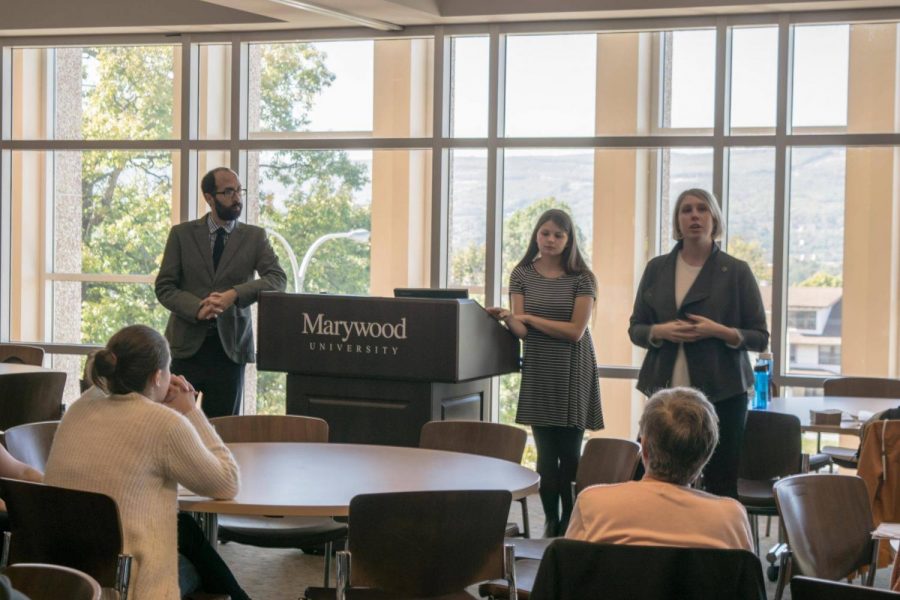Marywood professors discuss media literacy
Photo credit/ Bethany Wade
Dr. Adam Shprintzen, assistant professor of history, Brooke Williams, SCJ President and a junior broadcast journalism major, and Dr. Lindsey Wotanis, associate professor and director of Broadcast Journalism address the crowd.
October 17, 2017
In an age when terms such as “fake news” have become a standard part of many Americans’ vocabulary, recognizing what exactly media is and how to read the news is more important now than ever.
Dr. Lindsey Wotanis, associate professor and director of the Communication Arts broadcast journalism program, and Dr. Adam Shprintzen, assistant professor of history, jointly presented a Talk of the University titled “Media Literacy” on Oct. 4 in the Upper Main Dining Hall of the Nazareth Student Center.
Junior broadcast journalism major and President of the Society for Collegiate Journalists Brooke Williams joined the two faculty members in the presentation and prepared materials for the event.
The event was open to the entire Marywood community. The speakers used a slideshow to help lead the discussion of media and its role in the U.S., and used an interactive poll to test the audience’s knowledge of the First Amendment’s provisions.
Moderators discussed the difference between the terms “media” and “press,” explaining that media refers to both news and entertainment outlets, while the press is specific to news outlets. Additionally, the moderators noted that a free press, guaranteed by the First Amendment, is necessary because it holds public servants and leaders responsible for their actions.
Although there are many news outlets to choose from, the panel stressed that not all of them may be reliable or objective. Williams said the acronym ESCAPE may help those trying to distinguish facts from fiction. The letters stand for evidence, source, context, audience, purpose and execution.
“If you have a visceral reaction to a headline, that may be a sign of fake news,” said Wotanis, who also recommended audience members look at multiple media types and sources as a way to learn the full scope of events.
Shprintzen supported this suggestion by noting the connection between consuming news in the modern era and learning of events from the past.
“As a historian, if I want to find out something that happened 200 years ago, I’m not going to expose myself to one account,” said Shprintzen. “Exposing yourself to multiple outlets is the most reasonable way to determine what’s right.”
The moderators also informed audience members about fundamentals in journalism and what goes into reporting. As a rule, journalists are supposed to abide by a code of ethics that includes seeking truth and reporting it; minimizing harm; acting independently; and being accountable.
“My job as a journalist isn’t to get the words in order, but to make sure they’re true,” said Wotanis, noting instances where a source may be quoted accurately but the information given by the source is false.
Though journalists do strive for accuracy, mistakes can and do occur. In the event of erroneous reporting, she said, the ethical thing for journalists to do is acknowledge the mistake, correct it and apologize for the error.
Though journalists report the news, information also reaches consumers through social media outlets, everyday conversation, businesses and government officials. The panelists advised the audience to think before sharing a news piece and learn how the news is published and reported.
Editor’s Note: Dr. Wotanis and Brooke Williams were not involved in reporting this story.
Stephanie O’Malley contributed to this report.
Contact the writer: [email protected]





